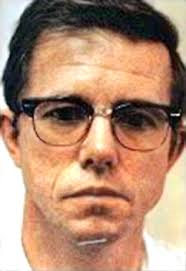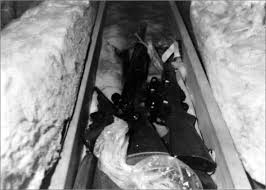?Shut up, sweetheart, or I?ll blow your brains out.?
 Robert Hansen
Robert Hansen
Robert Hansen is Alaska?s most notorious serial murderer. Several television shows have portrayed his life; numerous books have detailed his horrific deeds; and a 2013 movie, The Frozen Ground, starring John Cusack as Hansen and Nicholas Cage as an Alaska State Trooper, chronicles Hansen?s crimes and dramatizes the police investigation and apprehension of Hansen.
I hesitate to repeat this story, but if my goal is to recount some of the worst crimes in the history of Alaska, I would be remiss not to include those of Robert Hansen. This story is also important for two other reasons. First, it showcases the time during the construction and early operation of the trans-Alaska pipeline when thousands of people flocked to the state for jobs, and crime soared. Second, this case represents the beginning of the change in the criminal justice system in Alaska when investigative techniques, evidence processing, and dealing with sexual-assault crimes and victims moved out of the dark ages and into the present.
This is not a tale of Alaska?s criminal justice system at its finest. Hansen should have been caught and prosecuted years before he was, but a perfect storm of circumstances allowed him to remain free and continue killing. Robert Hansen was a skilled liar, able to talk his way out of nearly any situation. He owned a bakery and maintained a reputation as a respected businessman with powerful friends he could convince to lie for him and provide him with critical alibis. He was married with a family and had strong ties to his church. Hansen was smart and adept at navigating the wilderness. He was a pilot with his own plane, allowing him to kill and dump bodies in remote locations. He was also an avid big-game hunter with a small arsenal of guns he knew how to use well. Several of his trophies scored high in the record books, and his hunting buddies admired him. He did not fit a typical criminal profile, and on those occasions when he was caught doing something wrong, the justice system repeatedly gave him the benefit of the doubt, despite his criminal record.
Anchorage in the 1970s
 Alaska Pipeline
Alaska Pipeline
Anchorage in the early 1970s was a frontier town with growing pains. Construction began on the trans-Alaska oil pipeline in 1973, and it was completed in 1977. During this time, 28,000 people worked on the pipeline. Oil-field workers made good money, and while many pipeline employees hailed from Alaska, others came from the lower 48. The high wages created boomtown conditions in Fairbanks and Anchorage, and unemployment dropped to nearly zero in those cities. Off-duty workers spent lavishly, and crime rates spiked. Mobsters, drug dealers, prostitutes, and topless dancers followed the money to Alaska. Fourth Avenue in Anchorage became a string of endless taverns, and the Avenue was known as the longest bar in the world. Several topless bars opened in Anchorage, and the dancers and prostitutes who worked on Fourth Avenue lived a high-risk, nomadic lifestyle, often working awhile in Alaska, moving back to Seattle for a spell, and sometimes even traveling to Hawaii to work before perhaps again returning to Alaska. Few people noticed when a prostitute disappeared, and their absences rarely were reported to the police. This pool of transient, young women willing to climb into a stranger?s car for the promise of money, created the perfect atmosphere for a monster like Robert Hansen.
Law enforcement in Anchorage and throughout the state was not prepared for the rapid influx of people and the increase in crime in the early 1970s. As the population of Anchorage exploded, the city quickly expanded past the city limits in every direction. The Anchorage Police Department patrolled the city itself, but the Alaska State Troopers with a smaller force were not only responsible for policing the portions of Anchorage outside the city limits, but they were also charged with patrolling most of the rest of the state of Alaska. Criminals quickly learned they were less likely to be caught committing crimes outside the Anchorage city limits. By 1970, the Alaska State Troopers had developed no protocols for dealing with sexual assault cases, and Alaska did not have a decent crime lab for processing evidence. The Hansen case would change all this, but the changes came at a horrible price.
Robert Hansen
 Hansen
Hansen
Robert Hansen grew up in Pocahontas Iowa, 125 miles northwest of Des Moines. After graduating from high school, he joined the Army Reserves and received advanced military training at Fort Knox, Kentucky. Hansen returned to Iowa and worked at his father?s bakery in 1959. In 1960, he was arrested for setting fire to the bus barn at a local school and was convicted of arson and sentenced to three years in prison. A psychiatrist diagnosed Hansen with infantile-personality disorder and said Hansen imagined doing violence against girls who rejected him. Two years later, another psychiatrist reported that Hansen?s antisocial behavior had improved, and Hansen was paroled a year early.
Hansen soon met Darla Henrichson who was studying to be a teacher, and they married in 1961. Hansen then took a series of jobs in bakeries in Minnesota and North Dakota. In 1965, Hansen was arrested for shoplifting from a sporting goods store, but Darla persuaded the pastor at her Lutheran church to vouch for her husband, and the charges were soon dropped. The Hansens then moved to Anchorage, where Darla took a job as a teacher, and Robert worked as a baker. Darla was active in her church, and the couple enjoyed the outdoors. Robert was a serious hunter, and he shot record-book mountain goats, caribou, and Dall sheep. He soon met and became hunting buddies with John Sumrall, a well-respected Anchorage insurance man.
Hansen?s Crimes
In 1971, Hansen approached eighteen-year-old Susie Heppeard as she got out of her car at her apartment. He pointed his gun at her face and said, ?Shut up, sweetheart, or I?ll blow your head off.? Susie screamed, and one of her roommates called the police while the other roommate yelled at Hansen and told him the police were on the way. Hansen pushed his gun into Susie?s back and forced her toward the street, but when the police arrived, Hansen ran away into the night. The authorities easily apprehended Hansen, but he was released on his own recognizance. A month later, the grand jury charged him with assault with a deadly weapon.
Three days later, Hansen kidnapped a topless dancer and took her to a cabin on the Kenai Peninsula where he raped her. On the way back to Anchorage, he stopped the car, pointed his pistol at her, and told her to start running. She pleaded with him not to kill her, and Hansen finally relented and took her back to Anchorage. To keep her quiet, Hansen wrote down her parents? names and address and said he would kill them if she reported this incident to the police. If Hansen had known her father was an Alaska State Trooper, she might not have been so lucky. On Christmas day, when the half-naked body of a college freshman was found in a ravine near where Hansen had taken the dancer, the young dancer decided she couldn?t remain silent. She went to trooper headquarters, reported her abduction and rape, and identified Hansen from a photo.
Hansen was arrested again, and the latest charges were added to those already filed against him. On December 29th, Hansen was arraigned and held on $50,000 bail. Hansen?s family minister, as well as John Sumrall and another influential friend, appeared as character witnesses for Hansen and stated that Bob Hansen would not harm anyone. They argued the dancer must be mistaken. Hansen?s attorney attacked the topless dancer?s reputation and pointed out she used drugs. The charges in the case of the dancer were finally dropped, and Hansen received a five-year sentence for assaulting Susie Heppeard. He would be eligible for parole when doctors determined he was psychologically fit.
A psychiatrist diagnosed Hansen with schizophrenia and said Hansen would commit violent acts and then not remember them later. Hansen learned how to manipulate the prison system and was a model inmate, effortlessly convincing psychiatrists and jailers his condition had improved. He was released to a halfway house after serving only three months and soon was allowed to move home with his family.
Hansen owned a boat he moored in a small boat harbor at Seward, Alaska, 125 miles south of Anchorage. Megan Emerick was last seen July 7th, 1973, folding her laundry at a dormitory in Seward. Police believe Hansen murdered her and buried her on the shore of Resurrection Bay near Seward.
In the summer of 1975, friends drove Mary K. Thill to Seward. She got out of the car, and they never saw her again. Troopers believe Hansen also buried her near Seward.
A few weeks after Mary Thill disappeared, Hansen lured a dancer from the Kit Kat Club on the Old Seward Highway near Anchorage. He drove her to Chugach State Park, raped her, and then let her go. The woman reported the rape but refused to press charges. The trooper who took her statement notified Hansen?s parole officer, but Hansen claimed he thought he and the dancer were on a date, and the parole officer let the matter drop.
In November 1976, security guards caught Hansen trying to shoplift a chainsaw from a store in Anchorage. The court sentenced him to five years in prison and sent him to the Juneau Correctional Institute. After serving only sixteen months, the Alaska Supreme Court reviewed his case and decided since his other offenses were several years in the past, and since Hansen provided well for his family and was a respectable member of the community, he should be released. The judge who initially sentenced Hansen expressed outrage at the court?s decision. Soon after being released from prison, investigators believe Hansen committed a series of rapes and murders.
In 1982, Hansen opened his own bakery. Business thrived, and he soon made enough money to purchase a small airplane. The plane offered Hansen increased mobility. He no longer had to drive his victims into the wilderness to kill them. He could now fly them there.
The body of Joanna Messina was found in a gravel pit near Seward in May 1980. A second body was discovered two months later over a hundred miles away in a shallow grave on a remote road outside of Anchorage. The second victim was never identified. The two bodies were found so far apart, authorities assumed two different people had murdered the women.
On September 13th, 1982, two off-duty Anchorage police officers were moose hunting on the Knik River when they found the remains of Sherry Morrow on a sand bar. When Alaska State Trooper Sergeant Lyle Haugsven arrived to examine the remains, he began thinking about the growing list of missing dancers in Anchorage. Was there a serial killer prowling the streets of Anchorage? Haugsven compiled a list of women who had been reported missing, and then he created a suspect list. More than thirty names made his list, including Robert Hansen, but as the months passed and no more bodies surfaced, police rejected the idea of a serial killer and decided the murder of Sherry Morrow was an isolated event.
On June 13th, 1983, a trucker encountered a 17-year-old girl named Cindy running down a street near an airfield in Anchorage. A man with a gun was chasing her. Cindy was barefoot and handcuffed, and when the trucker stopped, she climbed in his truck. The trucker tried to convince Cindy to go to the police station, but she was confused and terrified and demanded he drop her off at a motel. He complied with her demands but then continued to the police station where he reported the incident. When Anchorage Police Officer Gregg Baker arrived at the motel, he found Cindy still in handcuffs and hysterical. Cindy led Officer Baker to the airfield and pointed out a plane and told Baker her assailant had tried to force her to climb into it. The aircraft was registered to Robert Hansen.
Police went to Hansen?s home, but he denied the incident had happened, saying he and another friend had been at John Sumrall?s home. Both friends backed up Hansen?s story, providing Hansen with an alibi for the time when Cindy said she was abducted. The prosecutor had to weigh the testimony of a teenage prostitute against the testimony of two highly regarded Anchorage businessmen, and he dropped the case before charges were brought.
On September 2nd, 1983 the body of another woman was found on the Knik River near the spot where Sherry Morrow?s body had been found, and Alaska State Trooper Sergeant Glen Flothe was assigned the case of the Knik River murders. Flothe remained convinced a serial killer stalked the streets of Anchorage, and Robert Hansen topped his list of suspects. He ordered twenty-four-hour surveillance on Hansen, and Flothe comprised a list of twenty-two missing women he felt were possible victims of the murderer.
The Investigation
Flothe contacted the FBI?s Behavioral Sciences Division and asked for their assistance in identifying the murderer. Agents John Douglas and James Horn came up with a profile stating the murderer stutters and is an excellent hunter. They said the unknown subject is a hardworking, successful businessman, and his wife is probably religious and not aware of her husband?s activities. Their profile perfectly described Robert Hansen and his wife, Darla. The FBI agents also told Flothe their killer likely has a stash of items, such as jewelry or clothes, he has taken from his victims and saved for trophies.
Flothe convinced a judge to issue a search warrant for Hansen?s bakery and house. Behind the headboard of Hansen?s bed, officers found an aviation map with twenty-four X marks on it, but at the time, the map meant nothing. An officer searching the attic in Hansen?s home found a cache of weapons, including a rifle they matched to shell casings found near the bodies on the Knik River. The officer also found a bag of jewelry: the souvenirs the FBI agents believed the murderer would have.
 Hansen?s weapons cache in his attic
Hansen?s weapons cache in his attic
With mounting evidence, John Sumrall and Hansen?s other buddy recanted their testimony, saying Hansen was not with them when Cindy was abducted. After several days of interrogation, Hansen finally confessed to killing fourteen women over twelve years, but when Flothe reviewed the evidence in the case, he came across the aviation map covered with the twenty-four X marks, and he realized each X might represent the burial spot of one of Hansen?s victims.
Authorities suspect Robert Hansen murdered more than thirty women, and some speculate he also murdered men. Although Hansen never admitted it, investigators believe from studying the evidence of where Hansen?s victims started and where they were finally killed, that Hansen would abduct a woman, take her into the wilderness, rape her, and order her to run while he hunted her down as if she were one of his big-game trophies.
Hansen was sentenced to 461 years plus life, without parole. With the aid of the marked aviation map of Southcentral Alaska, troopers found human remains near seventeen of the X-marks on Hansen?s map.
Hansen was incarcerated at the Spring Creek Correctional Center in Seward, and he died from natural causes on August 21st, 2014. After his conviction, his wife and children moved back to Arkansas to be near her family.
As an interesting side note, a few investigators believe Hansen could have been responsible for some of the murders attributed to the Green River killer in Seattle. Hansen denied any connection.
During the Hansen case, Alaska State Troopers began developing protocols for dealing with sexual assault cases and started building and supporting safe houses around the state for victims of abuse. Also, the Department of Safety in Alaska built a state-of-the-art, $56 million crime lab for evidence processing.
Unfortunately, much work still needs to be done in Alaska. A 2016 report by the Violence Policy Center ranked Alaska first nation-wide as the state with the highest homicide rate per capita of female victims killed by male offenders. According to a 2015 University of Alaska Justice Center victimization survey, fifty out of every one-hundred women residing in Alaska have experienced intimate partner violence, sexual violence, or both.
Sign up below for my free, monthly newsletter about murder and mystery in Alaska.

